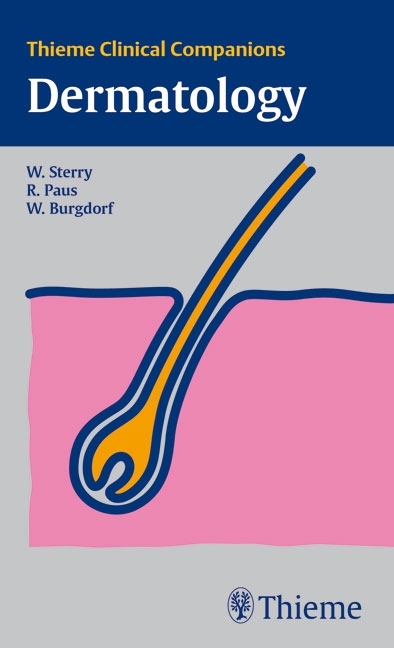Dermatology, the first book in the new Thieme Clinical Companions series, presents the essential information on how to diagnose and treat the full range of dermatologic diseases. Compiled by expert physicians, this pocket guide describes the diagnostic approach and therapeutic options for a wide range of skin diseases. More than 300 full-color illustrations, diagrams, checklists, charts, and clinical tips illuminate all concepts and techniques described in the text. Basic aspects of skin biology and disease pathophysiology are also covered.
To aid quick reference and review, the book is organized into the following color-coded sections:
- Introduction and Diagnosis: A concise overview of the biology and anatomy of the skin, followed by a step-by-step guide to the dermatologic evaluation.- Dermatologic Diseases: Extensive coverage of skin and hair disorders, with illustrations and essential information for each, including pathogenesis, clinical features, diagnostic approach, differential diagnosis, therapy, and more.- Therapy: Review of the current information on establishing a treatment plan, including topical, systemic, and radiation therapy, as well as operative dermatology, wound healing, and emergency treatment.- Useful Appendices: Common systemic medications and commonly used compounding recipes- Dermatologic Differential Diagnosis: Comprehensive charts (with numerous cross-references) designed to help the reader recognize and fully understand the patient's signs and symptoms.
All dermatologists, residents, and trainees will benefit from keeping this compact portable guide on hand in the clinical setting.
Gray Part: Introduction and Diagnosis
1 Introduction to Skin Biology
1.1 Overview
1.2 Functional Anatomy
1.3 Epidermis
1.4 Hair
1.5 Basement Membrane Zone
1.6 Dermis
1.7 Subcutis
1.8 Neuroendocrine-immune Networking
1.9 Outlook
2 Dermatologic Diagnosis
2.1 Components of the Dermatologic Evaluation
2.2 Description of Skin Findings
2.3 Primary and Secondary Lesions
2.4 Additional Descriptive Terms
2.5 Tools of the Trade
2.6 History
2.7 Histologic Diagnosis
2.8 Molecular Diagnostics
2.9 Mycologic Diagnosis
2.10 Diagnosis of Hair Disorders
3 Other Diagnostic Methods
3.1 Phlebologic Diagnosis
3.2 Allergy Testing
3.3 Light Testing
3.4 Ultrasonography
Blue Part: Dematologic Diseases
4 Viral Diseases
4.1 Overview
4.2 Poxvirus Infections
4.3 Herpesvirus Infections
4.4 Picornavirus Infections
4.5 Cutaneous Manifestations of Hepatitis Virus Infections
4.6 Human Papillomaviruses
5 Bacterial Diseases
5.1 Introduction
5.2 Gram-positive Bacteria: Staphylococci
5.3 Gram-positive Bacteria: Streptococci
5.4 Gram-positive Bacteria: Corynebacteria
5.5 Gram-negative Bacterial Infections
5.6 Miscellaneous Bacterial Infections
5.7 Zoonotic Infections
5.8 Borreliosis
5.9 Mycobacterial Infections: Tuberculosis
5.10 Mycobacterial Infections: Leprosy
5.11 Atypical Mycobacterial Infections
5.12 Actinomycosis
5.13 Nocardiosis
6 Fungal Diseases
6.1 Nomenclature
6.2 Dermatophytes
6.3 Yeasts
6.4 Subcutaneous Mycoses
6.5 Systemic Mycoses
7 Other Infectious Diseases
7.1 Leishmaniasis
7.2 Other Protozoan Infections
7.3 Pediculosis
7.4 Scabies
7.5 Other Epizoonoses
7.6 Worms
8 Sexually Transmitted Diseases
8.1 Overview
8.2 Syphilis
8.3 Endemic Treponematoses
8.4 Gonorrhea
8.5 Other Sexually Transmitted Diseases
9 HIV Infection and AIDS
9.1 Overview
9.2 Cutaneous Manifestations
9.3 Extracutaneous Manifestations
10 Allergic Diseases
10.1 Basic Mechanisms
10.2 Urticaria
10.3 Angioedema
10.4 Food Allergies
10.5 Other Allergic Diseases
10.6 Hyposensitization
11 Drug Reactions
11.1 Overview
11.2 Common Reactions
11.3 Severe Skin Reactions
11.4 Uncommon Reactions
11.5 Drug Pseudoallergies
12 Dermatitis
12.1 Atopic Dermatitis
12.2 Syndromes Associated with Atopic Dermatitis
12.3 Contact Dermatitis
12.4 Other Forms of Dermatitis
13 Collagen Vascular Disorders
13.1 Classification and Overview
13.2 Lupus Erythematosus (LE)
13.3 Dermatomyositis and Polymyositis
13.4 Morphea
13.5 Lichen Sclerosus
13.6 Systemic Sclerosis
13.7 Pseudoscleroderma
13.8 Mixed Collagen Vascular Disorders
13.9 Other Rheumatoid Diseases
13.10 Raynaud Syndrome
13.11 Graft-Versus-Host Disease (GVHD)
14 Autoimmune Bullous Diseases
14.1 Classification
14.2 Pemphigus Group
14.3 Pemphigoid Group
14.4 Subepidermal IgA-mediated Disorders
14.5 Dermatitis Herpetiformis
14.6 Overview of Diagnostic Approach
15 Purpura and Vasculitis
15.1 Overview
15.2 Purpura
15.3 Cutaneous Vasculitis
15.4 Variants of Cutaneous Vasculitis
15.5 Systemic Vasculitis
15.6 Livedo
15.7 Vessel Occlusion and Cutaneous Necrosis
16 Papulosquamous Disorders
16.1 Psoriasis
16.2 Psoriatic Arthritis
16.3 Reiter Syndrome
16.4 Seborrheic Dermatitis
16.5 Pityriasis Amiantacea
16.6 Pityriasis Rubra Pilaris
16.7 Pityriasis Rosea
16.8 Small-Patch Parapsoriasis
16.9 Erythema Multiforme
16.10 Erythroderma
16.11 Figurate Erythemas
16.12 Li
Sterry, Wolfram
Paus, Ralf
Burgdorf, Walter
| ISBN | 9783131359117 |
|---|---|
| Artikelnummer | 9783131359117 |
| Medientyp | Buch |
| Copyrightjahr | 2006 |
| Verlag | Thieme, Stuttgart |
| Umfang | 754 Seiten |
| Abbildungen | 345 Abb. |
| Sprache | Englisch |










